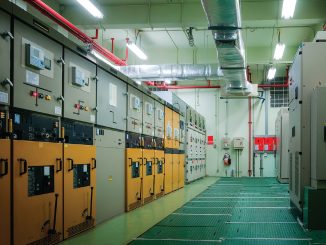
Coal-based power generation accounts for over 67 per cent of the overall power generation in the country. Therefore, limiting emissions from coal-based power generation is a huge challenge and a number of steps are being taken on this front. Supercritical and ultra-supercritical technologies have seen significant deployments in the Indian market as they can considerably increase the power plant’s total operational efficiency and aid in the reduction of emissions. In comparison to conventional subcritical units, these technologies are more effective, consume less coal, require less time to start up, offer more operational flexibility, and emit less CO2.
Apart from lowering emissions, thermal power plants (TPPs), which are primarily intended for baseload operation, are now required to run at partial load in order to handle the variable generation from renewable energy sources. Hence, digital solutions that improve the performance of boiler, turbine and generator (BTG) equipment and can enable them to operate flexibly at low load without compromising safety, performance and reliability are gaining traction.
A look at the key technology trends shaping the BTG market…
Technology trends
Ultra-supercritical and supercritical units are designed with higher steam parameters of 280 kg per cm2 at 600/600 °C and 247 kg per cm2 at 565/593 °C respectively. With the higher steam parameters, the efficiency of these units is 9 per cent and 5 per cent respectively higher than the efficiency of present typical 500 MW subcritical units. Ultra-supercritical and supercritical boilers are estimated to save around 2 per cent of fuel per unit of power generated, resulting in an 8 per cent reduction in emission intensity with respect to conventional subcritical power plants.
As of September 2022, 91 ultra-supercritical and supercritical units of sizes 660-800 MW with a total capacity of 63,030 MW (including two units of 1,320 MW) have been commissioned. The plant efficiency of these units is expected to be around 41.5 per cent, which is 3.5 per cent higher than that of a 500 MW conventional subcritical unit. As of March 2022, India’s largest power generator, NTPC Limited has commissioned 28 units based on ultra-supercritical and supercritical technologies with a total capacity of 19,740 MW.
Meanwhile, the country is making efforts to develop advanced ultra-supercritical technology (AUSC). Bharat Heavy Electricals Limited (BHEL), in association with the Indira Gandhi Centre for Atomic Research and NTPC, is developing AUSC technology under the aegis of the National Mission on Clean Coal Technology. The technology will yield the targeted efficiency of 45-46 per cent as against the efficiency of about 38 per cent of subcritical units and 41-42 per cent of supercritical units. AUSC technology has the potential to replace old and higher pollution emitting sets of more than 50 GW (TPPs that will be at least 30 years old by 2030) with the highest efficiency and lowest emission TPPs.
Besides AUSC, BHEL is developing coal gasification technology suitable for high ash Indian coal and has commissioned an indigenously designed 0.25 tpd coal-to-methanol pilot plant using a 1.2 tpd fluidised bed gasifier plant at Hyderabad. BHEL also plans to work with Coal India Limited and NLC India Limited to develop more coal gasification-based plants.
Integrated gasification combined cycle is another clean power generation technology that combines modern coal gasification technology with both gas turbine and steam turbine power generation. The technology has the potential to significantly improve the efficiency and emissions of coal power plants. It integrates a coal gasifier, a gas clean-up system and a gas turbine in a combined cycle mode where coal is gasified with either oxygen or air. The resulting synthesised gas (or syngas) consisting of primarily hydrogen and carbon monoxide is cooled, cleaned and fired in a gas turbine.
Digitalisation trends
Given the complexities and scale of operations across TPPs, it is imperative for them to take decisions in real time, as delays lead to huge losses and catastrophic events. Today, power plants are increasingly embracing digitalisation and reaping its benefits.
The use of digital tools, including advanced tools, sensors, artificial intelligence (AI), digital twins and machine learning, helps in effective remote monitoring and analysis for spotting potential defects before they arise in the power plants. The real data parameters also aid in creating a maintenance strategy, increasing reliability, and forecasting energy generation.
Many operators are beginning to transition to intelligent, preventive maintenance based on cutting-edge sensors and internet of things. Defects can be identified and fixed before any serious damage occurs, which can prevent surprise breakdowns and result in huge cost overruns.
Using digital twins, operators are able to model the present state of every asset in a digital power plant. The models start by providing guidance on the design limits of a power generation unit at the commissioning stage or inferring the design limit for an existing plant by matching the equipment to thousands of other similar equipment in the database. The digital twin allows plant operators to optimise plant efficiency and performance, make informed decisions, and perform maintenance tasks at the right time.
These models also accurately represent the plant under a large number of variations related to operation – fuel mix, ambient temperature, air quality, moisture, load, weather forecast models, and market pricing. Using these digital twin models and state-of-the-art techniques of optimisation, control and forecasting, applications can more accurately predict outcomes pertaining to plant availability, performance, reliability, wear and tear, flexibility, and maintainability.
Further, digitalisation offers advantages including improvement in personnel safety as digitalisation helps in safe monitoring through drones as well as robot-based repair of dangerous parts. Furthermore, digital equipment and real-time monitoring helps in the early identification of issues before they become dangerous. In addition, with AI and sensors, a TPP will be provided with a list of probable causes for the anomaly. The response in these situations is standardised, reducing uncertainty and panic.
Outlook
Over the next few years, as demand revives and power utilities initiate refurbishment projects, tendering for ultra-supercritical and supercritical units is expected to see further traction. Earlier, in May 2022, after a long gap of six years, NTPC awarded a contract to BHEL for the construction of a 1,320 MW supercritical plant in Talcher, Odisha. The project will comprise two supercritical units of 660 MW each. In Talcher, NTPC was operating one of its oldest plants, a 460 MW unit that was shut in March 2021 after 54 years.
Going forward, according to Central Electricity Authority data, 38 ultra-supercritical and supercritical units aggregating 27,180 MW capacity are under construction. Of these, 14 units totalling 9,940 MW (10 units in the central sector totalling 7,300 MW and four units in the state sector totalling 2,640 MW) are based on ultra-supercritical technology. It is expected that the efficiency of coal-based generation would improve further in the period 2022-27 due to the commissioning of ultra-supercritical and supercritical units.
Overall, thermal power generation is the backbone of the Indian power sector and will continue to play a significant role in power generation in the country due to the abundant availability of domestic coal. However, environmental concerns necessitate the adoption of clean coal technologies such as ultra-supercritical and supercritical. Higher-sized units of 660-800 MW based on ultra-supercritical/supercritical technology will not only accelerate the pace of capacity addition but will also have a positive impact on the environment due to lower CO2 and SOX emissions per unit of electricity generated.



